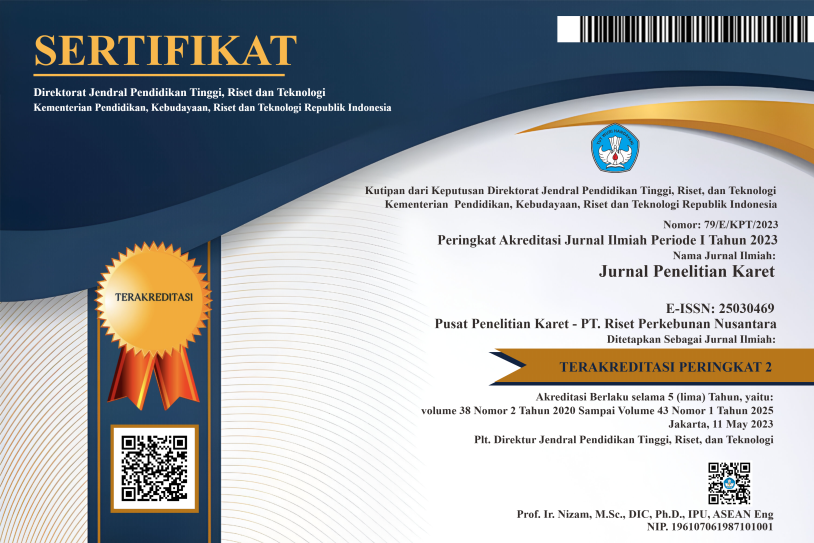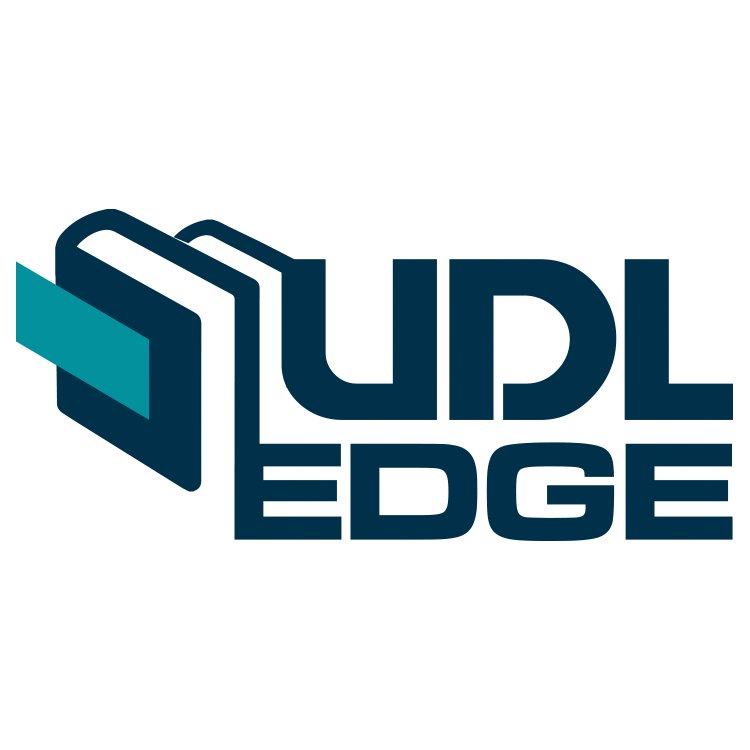KAJIAN SIFAT FISIKA DAN MORFOLOGI KARET ALAM SELULAR PADA VARIASI TIPE BAHAN PENGEMBANG DAN BOBOT KOMPON
DOI:
https://doi.org/10.22302/ppk.jpk.v41i2.837Keywords:
aditif pengembang organik, Azodicarbonamide, kepadatan, rasio ekspansiAbstract
Busa karet alam yang memiliki struktur mikro-seluler (karet selular) merupakan bahan berbasis biopolimer yang menarik untuk dikembangkan. Beberapa keunggulan karet selular diantaranya ringan, ergonomis karena bersifat berpori, dan ekonomis sehingga cocok digunakan sebagai produk barang jadi karet untuk berbagai keperluan mulai dari teknik hingga rumah tangga. Pada penelitian ini dibuat karet selular dengan menggunakan Azodikarbonamida (ADC) sebagai bahan pengembang (blowing agent). ADC yang digunakan divariasikan menjadi tipe A dan C. Lebih lanjut, bobot kompon karet yang akan dicetak menjadi karet selular divariasikan sebesar 8; 12; 13,5; 15; dan 17 gram. Pembuatan karet selular mengacu pada metode umum pembuatan kompon karet dilanjutkan dengan pencetakan. Evaluasi mutu karet selular dilakukan melalui pengujian visualisasi struktur morfologi, densitas, dan rasio ekspansi. Berdasarkan hasil pengujian diperoleh bahwa bobot kompon terbaik adalah sebesar 13,5 gram karena menghasilkan karet seluler dengan struktur morfologi seragam. Sementara tipe bahan pengembang dipilih tipe A karena menghasilkan karet seluler dengan densitas rendah namun rasio ekspansi tinggi.
References
Alam, L., & Honggokusumo, S. (1998). Pengeringan karet konvensional dengan bahan bakar briket batubara. Jurnal Penelitian Karet, 16(1–3): 1–21.
Bozhou, Z., Liu, Y., & Yang, F. (2018). Experimental and numerical study on deformation performance of Rubber-Sleeved Stud connector under cyclic load. Construction and Building Materials, 192: 79–193.
Chandrasekara, G., Mahanama, M. K., Edirisinghe, D. G., & Karunanayake, L. (2011). Epoxidized vegetable oils as processing aids and activators in carbon-black filled natural rubber compounds. Journal of the National Science Foundation of Sri Lanka, 39(3), 243–250.
Nabil, H., & Ismail, A. R. A. (2013). Compounding, mechanical and morphological properties of carbon-black-filled natural rubber/recycled ethylene-propylene-diene-monomer (NR/R-EPDM) blends. Polymer Testing, 32(2): 385–393.
Kim, J. H., Koh, J. S., Choi, K. C., Yoon, J. M., & Kim, S.-Y. (2007). Effects of foaming temperature and carbon black content on the cure characteristics and mechanical properties of natural rubber foams. Journal of Industrial and Engineering Chemistry, 13(2): 198.
Kim, J., Choi, K., & Yoon, J. (2006). The foaming characteristics and physical properties of natural rubber foams: effects of carbon black content and foaming pressure. Journal of Industrial and Engineering Chemistry, 12: 795.
Mayasari, H. E., & Wirapraja, A. Y. (2019). Pengaruh jenis bahan pengisi terhadap karakteristik pematangan kompon kloroprena/karet alam. Jurnal Teknologi Proses dan Inovasi Industri, 4(1).
Nomoto, A., Yasutaka, H., Oketani, S., & Matsuda, A. (2016). 2-Dimensional homogenization FEM analysis of hyperelastic foamed rubber. Procedia Engineering, 147: 431–436. doi: 10.1016/j.proeng.2016.06.335
Phromjan, J., & Suvanjumrat, C. (2018). A suitable constitutive model for solid tire analysis under quasi-static loads using finite element method. Engineering Journal, 22(2): 141–155. doi: 10.4186/ej.2018.22.2.141
Rostami-Tapeh-esmaeil, E., Vahidifar, A., Esmizadeh, E., & Rodrigue, D. (2021). Chemistry, processing, properties, and applications of rubber foams. Polymers, 13(10): 1–53. doi: 10.3390/polym13101565
Sombatsompop, N., & Lertkamolsin, P. (2000). Effects of chemical blowing agents on swelling properties of expanded elastomers. Journal of Elastomers and Plastics, 32(4): 311–328.
Tangboriboon, N., Pannangpetch, W., Aranyik, K., Petcharoen, K., & Sirivat, A. (2015). Embedded eggshells as a bio-filler in natural rubber for thermal insulation composite foams. Progress in Rubber Plastics and Recycling Technology, 31: 189–205.
Vahidifar, A., Khorasani, S. N., Park, C. B., Khonakdar, H. A., Reuter, U., Naguib, H. E., & Esmizadeh, E. (2016). Towards the development of uniform closed cell nanocomposite foams using natural rubber containing pristine and organo-modified nanoclays. RSC Advances, 6(59): 53981–53990. doi: 10.1039/c6ra08168a
Ariff, Z. M., Zakaria, Z., Tay, L. H., & Lee, S. Y. (2007). Effect of foaming temperature and rubber grades on properties of natural rubber foams. Journal of Applied Polymer Science, 107: 2531.
Zakaria, Z., Ariff, Z. M., Lee Hwa, T., & Stephen Sipaut, C. (2007). Effect of foaming temperature on morphology and compressive properties of ethylene propylene diena monomer rubber (EPDM) foam. Malaysian Polymer Journal (MPJ), 2(2): 22–30.
Downloads
Published
How to Cite
Issue
Section
License
Copyright (c) 2023 Sherly Hanifarianty, Mohammad Irfan Fathurrohman

This work is licensed under a Creative Commons Attribution-ShareAlike 4.0 International License.
Submission of a original research article in Jurnal Penelitian Karet implies that the submitted  manuscript has not been published in any scientific journal (except being part of the abstract, thesis, or report). The submitted manuscript also is not under consideration for publication elsewhere. All co-authors involve in the publication of the manuscript should give their approval.
Once, the manuscript is accepted and then published in Jurnal penelitian Karet, the Author(s) keep hold the copyright and retain publishing right without restrictions.
Author(s) and Jurnal Penelitian Karet users are allowed to multiply the published manuscript. The journal users are also permissible to share the published manuscript with an acknowledgement to the Author(s). The Editorial Boards suggest that the Authors should manage patent before publishing their new inventions.
















